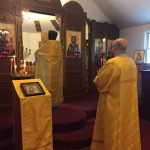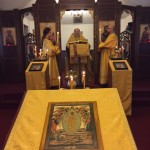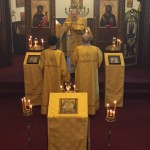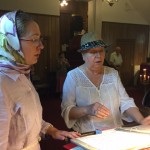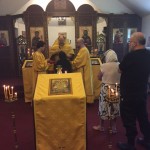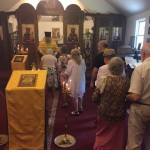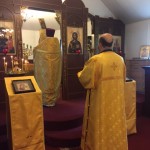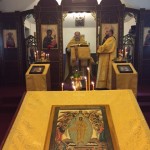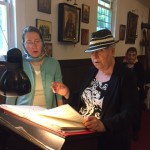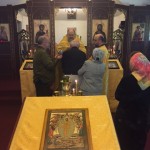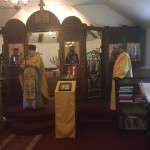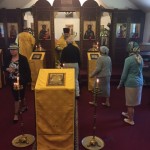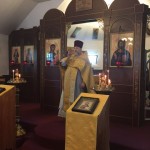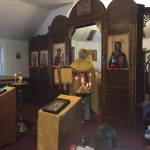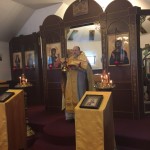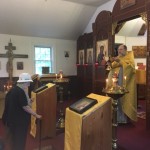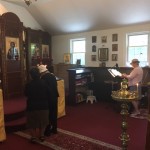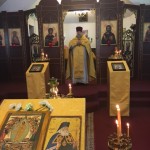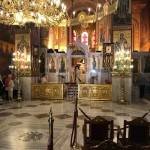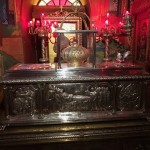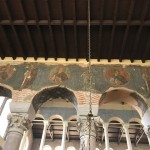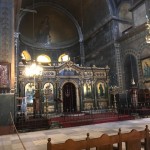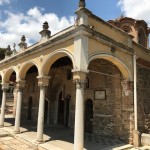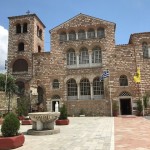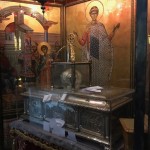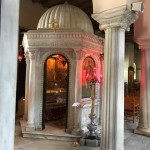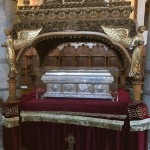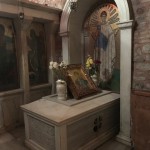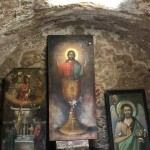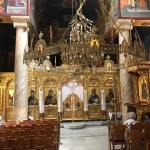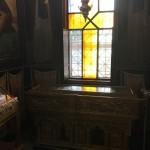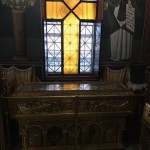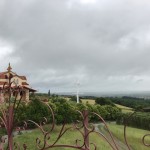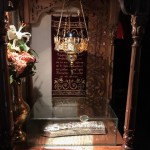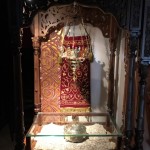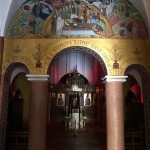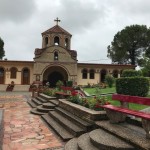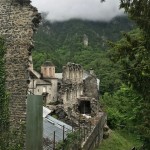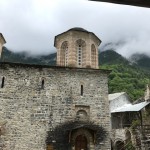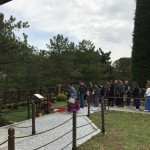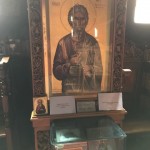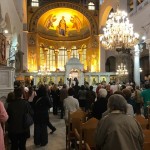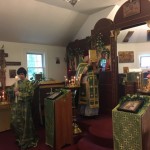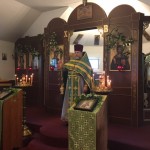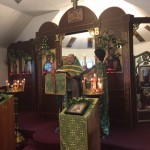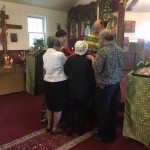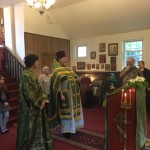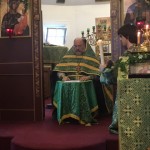by Archpriest Igor Tarasov
Continuing my story of the pilgrimage to Greece I will now come to describe my journey to the Holy Mountain Athos.
On Monday, May 29, in the afternoon I met my group of pilgrims that had to go to Mt. Athos at Thessaloniki airport. The group was headed by His Grace, Philaret, Bishop of Lviv and Halych, and included four other persons. After our meeting at the airport we went to the town of Ouranoupolis where we were supposed to receive our passes to Mt. Athos. We were given those documents and took a motor boat to sail for Mt. Athos.
It takes about a half hour to get to Mt. Athos from Ouranoupolis on a motor boat. Soon we moored to a pier of the oldest monastery on the Holy Mountain, Vatopedi. Hermits and monks began to live here from the 4th century, but the monastery itself was founded in the 10th century by three monks, Athanasius, Nicholas and Anthony, the disciples of Ven. Athanasius of Athos. Now it has a lot of monks and nice architectural objects.
Since it was late, we went to sleep and had to wake up very early for the church services.
Daily services at Mt. Athos usually begin at 5 am. We were given a leeway and asked to join the brotherhood at 6. Bishop Philaret was given the high throne in the church while all of us took the seats along the walls of the temple. In this way we prayed during the Matins and Hours and later participated in the Divine Liturgy which was headed by Bishop Philaret. It was an interesting experience to listen to the Byzantine chants and prayers of the Athonite monks.
Following the services we proceeded to the monastery refectory, the trapeza. It is an old building having the Byzantine marble tables made in the 8th century and later donated for the monastery. Very simple food was very delicious and healthy. It included lentil soup, fruits, vegetables, feta cheese and olives. All fruits and vegetables were locally grown, mostly at the monastery fields.
After finishing our trapeza we were invited to venerate the holy relics kept in Vatopedi monastery. These relics include the Precious Cincture (Belt) of the Most Holy Mother of God, a part of the head of St. John Chrysostom along with his ear, the Cross of Emperor Constantine and part of the relics of Ven. Joseph the Hysichast. In addition, the monastery temples keep several miraculous icons of the Most Holy Mother of God. These are the Icon of the Mother of God of the Altar (Vimatarissa), the Icon of the Mother of God Streaming of Oil, the Icon of the Mother of God the Queen of All (Pantanassa), and the Icon of the Mother of Consolation (Paramythea). We were very happy and spiritually uplifted to have an opportunity to venerate all these relics and the miraculous icons.
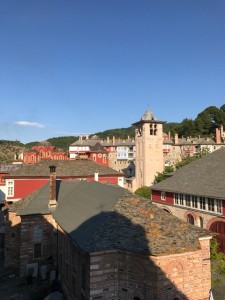 Vatopedi Monastery
Vatopedi Monastery
It would love to stay at Vatopedi longer but our group had to visit other holy places. Thus, we drove to the kellia Maruda attached to the Serbian monastery Hilandar where elder Macarius leads an ascetic life. Elder Macarius was one of the Greek Athonite monks who preached and lived in the United States, along with elder Ephrem of Arizona. Now he prefers to stay on Mt. Athos. We were warmly welcomed by the elder, had a nice conversation with him. Then each person from our group had an individual meeting with the elder. Our plan was to go further but elder Macarius nicely invited us to have a trapeza with him, and we accepted that invitation. Again, the food was very simple but delicious and healthy.
Leaving very hospitable and deeply spiritual Fr. Macarius we drove to the other side of Mt. Athos, to Simon on the Rock Monastery, in Greek Simonopetra. The roads on the Holy Mountain are not finished and they are very bumpy. In addition, we had to climb or come down from the hills. But we endured these inconveniences.
The Simonopetra Monastery is beautifully situated on the huge rock above the sea. It is probably one of the most beautiful places of Mt. Athos. Coming to the monastery we visited the main temple and venerated the right hand of St. Mary Magdalene, the main holy relic of this monastery.
 On the balcony of Simonopetra Monastery
On the balcony of Simonopetra Monastery
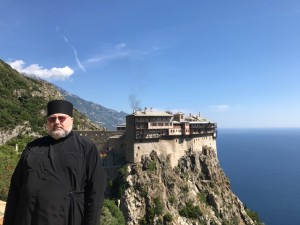 View at Simonopetra Monastery
View at Simonopetra Monastery
Our next place to visit on that day was the monastery known as Xenophontos. This monastery is known for its large library, as well as because it has a residence of the Ecumenical Patriarch. We prayed at Vespers at the Xenophontos main temple known for its best acustics on the Holy Mountain. This was also adorned by the fabulous voice of the monastery abbot, Fr. Alexy who proclaimed certain parts of the service. Following the Vespers we enjoyed delicious trapeza at Xenophontos refectory and later had a meeting with Abbot Alexy in his office. The monastery patron is Holy Great Martyr George, so, as Rector of St. George Church, I was especially uplifted to visit that place. We were given an opportunity to venerate a part of St. George relics, as well as the famous Icon of the Most Holy Mother of God “Showing the Way” (Hodegitria).
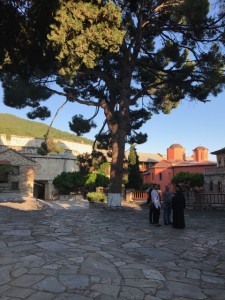 The yard of the Xenophontos Monastery
The yard of the Xenophontos Monastery
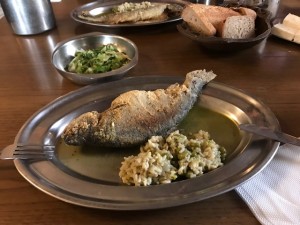 Evening trapeza at Xenophontos Monastery
Evening trapeza at Xenophontos Monastery
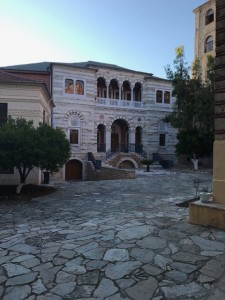 The residence of the Ecumenical Patriarch at Xenophontos
The residence of the Ecumenical Patriarch at Xenophontos
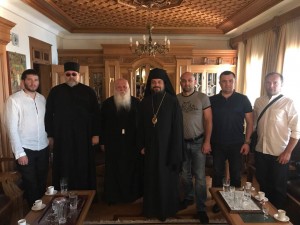 Meeting with the Abbot of Xenophontos, Fr. Alexy
Meeting with the Abbot of Xenophontos, Fr. Alexy
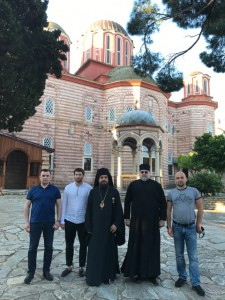 Our group near the main temple of Xenophontos
Our group near the main temple of Xenophontos
Our night accommodations were reserved in another famous monastery, the Russian monastery of St. Panteleimon where we headed after visiting Xenophontos. We arrived there at sunset and were given relatively large rooms to spend a night. On the next morning, on Wednesday, May 31, we went to the main monastery temple to pray. At this early time, after the sunrise, we could see that the temple architecture here was influenced by the Russian style. We participated in the Matins service and the Hours. Services were held in Slavonic language. Then by the blessing of Bishop Philaret I joined him in celebration of the Divine Liturgy. It had been a special spiritual feeling to serve the Liturgy at St. Panteleimon’s monastery, a blessed place where many of the monks from Rus’ used to pray, serve and lead an ascetic life.
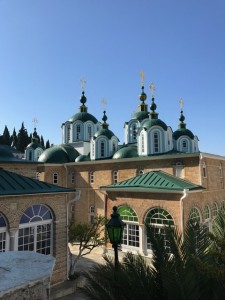 The main church of St. Panteleimon Monastery
The main church of St. Panteleimon Monastery
Following the Liturgy all the monks and pilgrims were led to trapeza. The food at St. Panteleimon had already some Slavic influence: we had mashed potatoes which not usually eaten in Greece.
After the trapeza the pilgrims were offered an opportunity to venerate the multiple holy relics kept at St. Panteleimon Monastery: of Holy Great Martyr Panteleimon, foot of Holy Apostle Andrew, head of Holy Apostle Luke, parts of the relics of the Apostles Peter, Thomas, Philip, Bartholomew and Barnabas, part of the relics of Holy First Martyr Stephen and some other relics. We had also venerated the Jerusalem Icon of the Mother of God.
We left St. Panteleimon Monastery to return to Vatopedi where we had a scheduled appointment with its abbot, Fr. Ephrem. Arriving there we were warmly welcomed by Fr. Ephrem at his residence. We had delicious sweets and coffee at the residence balcony and conversed about a number of issues which concern Orthodox Church. Special attention, of course, was given to the life of the Church in Ukraine.
After a nice meeting with Fr. Ephrem we went to see a number of places on the Holy Mountain. We arrived in the St. Andrew Skete, a very large monastery built on Mt. Athos by the Russian tsars in the 19th century. Before Russian Revolution it had around 700 monks living there. However, following the disturbances in Russia most of the monks left that place. It later became taken over by the Greeks and now it is attached to Vatopedi Monastery. The main church of St. Andrew Skete is the largest temple on Mt. Athos. It is built in the Russian style. We had an opportunity to venerate part of the relics of Holy Apostle Andrew. After visiting the temple we met Metropolitan Paul of Khanty-Mansiysk, a Russian bishop who used to serve in our Patriarchal Parishes. Giving us his archpastoral blessing, Metropolitan Paul wished our American Orthodox community all God’s graces. We also were charmed to see the large Russian bell on the monastery yard which, unfortunately, could not be hanged at the bell tower, and we took some pictures near it.
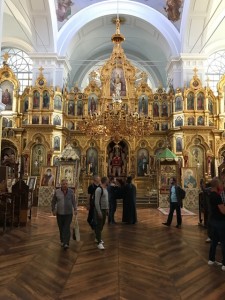 Inside the main temple of St. Andrew Skete
Inside the main temple of St. Andrew Skete
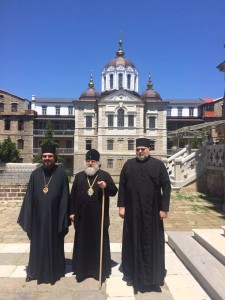 Bishop Philaret, Metropolitan Paul and I in St. Andrew Skete
Bishop Philaret, Metropolitan Paul and I in St. Andrew Skete
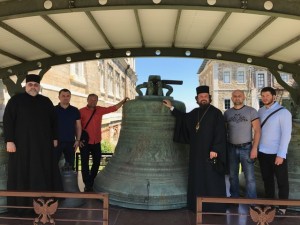 A picture near the large Russian bell
A picture near the large Russian bell
Following that we visit Karyes, an administrative capital of Athos where the governing offices of this monastic republic are situated. Near that capital we visited the monastery called Kutlumush, by the name of its legendary Arab founder. It is a cozy place where we could venerate the Passion Icon of the Most Holy Mother of God.
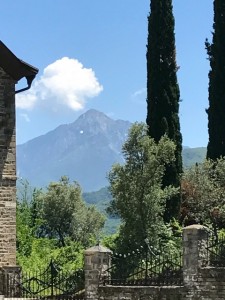 A view at Mt. Athos peak
A view at Mt. Athos peak
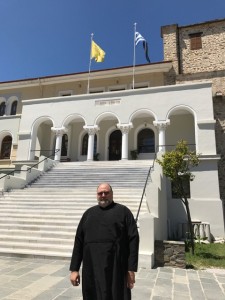 Near the main administrative building in Karyes, the capital of Athos
Near the main administrative building in Karyes, the capital of Athos
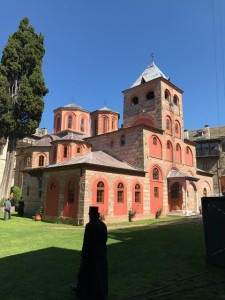 The Kutlumush Monastery
The Kutlumush Monastery
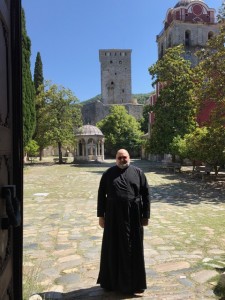 Inside the walls of Kutlumush
Inside the walls of Kutlumush
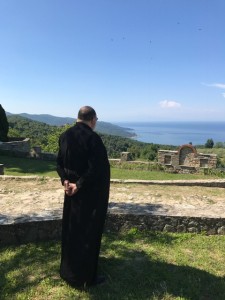 Looking at the beautiful view
Looking at the beautiful view
After Kutlumush and the Athos’ capital we drove to the known Iveron Monastery. It used to be a Georgian monastery, however later it became totally populated by the Greek monks. Here we prayed before the Iveron Icon of the Most Holy Mother of God, also known as the Portatissa (the Gate Keeper). According to the tradition, the icon was at one time in the possession of a widow in Nicea. Not wanting the icon to be seized and destroyed by the iconoclasts, she spent all night in prayer and then cast the icon into the Mediterranean Sea. The icon had been found in the waters near Mt. Athos and recovered from the sea by a Georgian monk. The tradition goes on to say that the following day, when the monks entered the church they could not find the icon. After searching they discovered the icon hanging on the gates of the monastery. This occurrence was repeated several times, until the Georgian monk reported that he had seen a vision of the Theotokos, wherein She revealed that She did not want Her icon to be guarded by the monks, but rather She intended to be their Protectress. After this, the icon was permanently installed above the monastery gates, where it remains to this day. Because of this, the icon came to be called Portaitissa or “Gate-Keeper”. We can add that the copy of this icon is very much revered in Russia, in the city of Moscow and was also known as miraculous.
Later, in the afternoon we came to the Philotheou Monastery where we had a chance to venerate the Icon called “the Sweet Kiss”, along with the relics such as the right hand of St. John Chrysostom and part of the relics of St. Cosmas and Damian. Then we headed to the monastery known as St. Paul’s (Agiou Pavlou) because it was founded by a holy monk, Ven. Paul. There had an opportunity to see and to venerate the relics known as the Gifts of the Wise men.
Our plan was to spend the last night on the Holy Mountain at the Skete of St. Ann, a place situated very high on the mountain above the sea. In order to get to the skete you need either to climb the stairs for about one hour or to ride there on a mule. I was generously offered to mount a mule. In this way I got to the skete while other members of our group preferred to take the steps by foot. The rise was long and hard but we did not regret it. The view from St. Ann Skete on the sea and the mountains was spectacular. And the monks living there were very welcoming and nice to us. We had a nice supper at that great evening conversing about different spiritual and life matters.
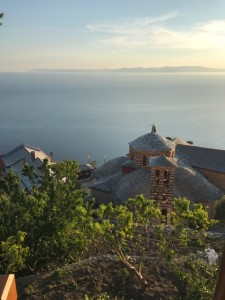 A spectacular view from the mountain of St. Ann Skete
A spectacular view from the mountain of St. Ann Skete
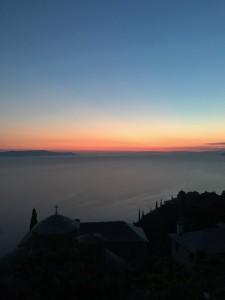 The night view from St. Ann Skete
The night view from St. Ann Skete
On Thursday, June 1, on the morning of our last day on Mt. Athos, we got up early for the celebration of the Divine Liturgy at the little chapel attached to our kellias. Bishop Philaret served the Liturgy while I served as a cantor and members of our group prayed. Finishing the Liturgy and receiving the Holy Communion we had a trapeza with the monks of the skete.
Following the delicious trapeza we visited the main church of the skete where were given an opportunity to venerate the relics, especially the foot of St. Ann, Mother of the Thetokos. That foot preserved not only the skin, but also veins and many pilgrims claimed that they felt the warmth of the foot when they kissed it. It should be noted that the skete is a known pilgrimage place for childless men who ask St. Ann’s intercession. According to the testimony of faithful, St. Ann had helped many. Childless couples who had children after these pilgrimages bring pictures of their children born by the prayers of St. Ann, so there are a lot of such photographs in the temple.
After thanking the monks, especially their abbot, Fr. Gabriel for the nice welcome, we started our descent from the mountain to the sea shore. This time we all walked by foot, and it was a little hard because the steps there are made of different and uneven rocks. It took us around 40 minutes to walk down.
At the pier we waited on our motor boat which arrived soon and took us back to Ouranoupolis. We returned to the mainland Greece, to the secular world. But we desired to keep the great spirit of the Holy Mountain in our hearts.
Concluding my short story about our pilgrimage to the Holy Mountain I wish to express my special gratitude to His Grace, Bishop Philaret who headed our small group of pilgrims and was giving us a great spiritual inspiration and guidance during this journey. Thanks to Bishop Philaret who is well known to the Athonite brotherhood we were given a very nice welcoming at every place we visited. I wish to thank all the members of our group for their moral and prayerful support and brotherly attitude. And, of course, I am very grateful to our Archpastor, Bishop John who gave me a blessing to undertake this unforgettable pilgrimage.

